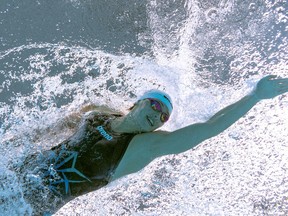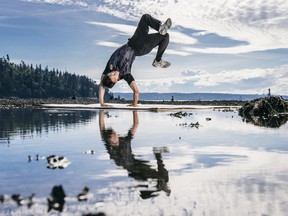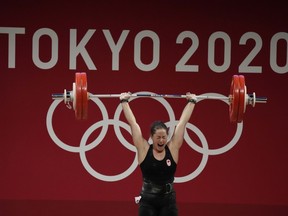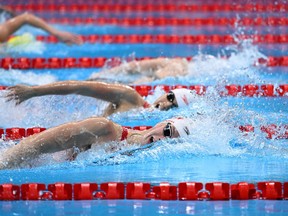Canadians are favoured for a podium finish in swimming, breaking and weightlifting.
Article content
Postmedia may earn an affiliate commission from purchases made through our links on this page.
Over the next two weeks, the best in the world will be putting their athleticism on display as they compete at the 33rd Summer Olympic Games in Paris. Power, speed, strength, agility, flexibility and endurance are the hallmarks of athletic performance, but not all sports have the same physiological requirements. And not all Olympians possess the same set of athletic tools. Here’s the inside scoop on what it takes to excel in three Olympic sports where Canadians are favoured for a podium finish.
Advertisement 2
Article content
Swimming

All eyes will be on the pool as Canadians Summer MacIntosh, Maggie Mac Neil, Penny Oleksiak, Kyle Masse and Josh Liendo vie for swimming medals.
A technical sport with four different strokes to master, most elite swimmers start training by their 10th birthday and specialize in their early to mid-teens. MacIntosh’s mother swam in the 1984 Olympics. Oleksiak’s siblings are also elite athletes, which according to Greg Wells, exercise physiologist, senior scientist in exercise medicine at the Hospital for Sick Children and former director for sports science at the Canadian Sport Institute Ontario, makes them very trainable. Hence their breakout in the international scene as teenagers. Most other swimmers hit their physical peak in their early to mid-20s.
Oleksiak’s 186-cm (6’1”) frame is the ideal swimmer’s body; long, lean and with an arm span greater than her height (most arm spans are equal to height). Despite the lean frame, swimmers have more muscle mass than they did a decade or so ago thanks to a greater emphasis on weight training.
As for how often they hit the water, Wells says specialists in 50 and 100 metres, 200 and 400 metres and 800 and 1500 metres vary in the number of hours they spend in the pool. Distance swimmers train up to 40 hours a week, while sprinters train about half that time but at a much higher intensity. Middle-distance swimmers log about 70 per cent the time of distance swimmers with more intensity.
Advertisement 3
Article content
Not all that time is spent doing laps. Starts and turns are critical to success, so swimmers work in and out of the pool improving their explosiveness and underwater technique off the blocks and wall. Watch Mac Neil come off the wall in the 100 fly and Masse’s start in the 100- and 200-metre backstroke to witness the importance of gaining as much distance as possible while underwater.
Breaking

A new sport at the Paris Olympics, breaking has evolved from dance battles on the streets of New York City to a competitive sport that mixes the creativity of dance with explosive moves that require strength, power, agility and flexibility. Breakers (B-Boys and B-Girls) compete one-on-one in a dance battle consisting of three alternating one-minute rounds. They start standing (top rock), showing off intricate foot work before moving to the floor (down rock), where most of the power moves happen.
According to Geoff Reaves, high performance sports director for Breaking Canada, most breakers have short, compact builds with a strong upper body. A shorter stature allows them to move in and out of spins and other power moves faster than someone taller, which is why the best breakers in the world look more like gymnasts than basketball players.
Advertisement 4
Article content
In fact, breakers often come from gymnastics or dance, taking up the sport in their early to mid-teens. Some of the athletes competing in Paris are pushing 40, while others are teenagers, making it one of the rare sports where athletes can have a career into middle age.
Daily workouts last up to three hours and are spent primarily in the dance studio. Most of the new generation of B-Boys and B-Girls include strength training to their weekly routine, but according to Reaves not everyone in the breaking community is sold on the value of training outside of the dance studio.
It doesn’t help that there’s very little sports science related to breaking. Without evidence-based training strategies designed to maximize performance, there’s little consensus on a training program designed to create podium finishers. And since creativity and musicality account for a large part of the scoring, the physical attributes of breakers are just some of the qualities needed to succeed.
“Big moves don’t necessarily win,” Reaves said.
Phil Kim, a.k.a. Phil Wizard, is Canada’s best chance for a medal. He started breaking as a tween and at age 34 is at the top of his game. Known for his creativity and big power moves, he’s ranked in the world top 10.
Advertisement 5
Article content
Weightlifting

Weightlifting started as a field event in the 1896 Olympic Games in Athens before becoming its own event in 1920. A male-only sport until the Australia Games in 2000, Canadian Maude Charron is hoping to repeat the gold she won in the 64 kg weight class at the 2020 Tokyo Games.
Charron was a gymnast who later attended circus school before taking up CrossFit, where she was recruited by a weightlifting coach at age 20. Unlike a lot of sports, there’s no standard development path to weightlifting, said Mac Read, high performance manager for Weightlifting Canada. Nor is there a typical age where athletes take up the sport. And while most weightlifters reach their peak in their 20s, Charron is still a contender at 31.
“Athletes come from a lot of different sports,” Read said. “We have athletes who have played in the CFL, competed in figure skating, CrossFit and gymnastics.”
Lifters need to move heavy loads quickly, which is what coaches look for when spotting talent. They perform two different lifts with the winner determined by who lifts the most combined weight. The snatch brings a heavy barbell from the floor to overhead in single movement. The clean and jerk requires a similar movement pattern but rests the bar on the shoulders before pushing overhead. Athletes have three attempts to lift the weight.
Training takes place eight to nine times a week with one or two days off. And since many weightlifters work full- and part-time jobs or are in school, they juggle their training with work and education. And unlike other sports, Canadian weightlifters don’t centralize their athletes in high performance centres.
“Our athletes train in gyms, barns and schools,” Read said.
Recommended from Editorial
Advertisement 6
Article content
Article content



